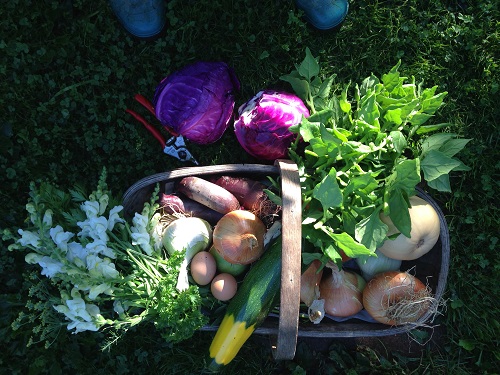This year due to the global pandemic, many people are taking up vegetable growing. I tend to grow most of our vegetables, so here are my tips:
My top vegetable recommendations in order of priority
- Mixed salads including radish – sow early and successionally for early summer harvests
- Sugar snap peas – sow early and successionally – good for using vertical space and providing fresh pods and tendrils (and peas)
- Martock beans – sow early for fresh or stored ‘beans’ (dried or frozen). This is an Heirloom variety
- Trombone squash – sow mid April for young fruit which act as an alternative to courgettes in mid summer. Mature fruit keep through the winter (I do tend to grow these in a poly tunnel due to the unpredictability of the Somerset weather)
- Borlotti and purple climbing beans – sow mid April for fresh pods or stored beans (dried or frozen)
- Leeks – sow early or mid April, these will crop from the autumn and through the winter
- Celeriac – this is wonderful but requires a very early start in the year, I wouldn’t be without it as it keeps all winter
Perennial easy vegetables (& fruit) which are a must
- Perennial kale which crops all year round – I am taking extra cuttings to give away in the autumn
- Black currants, red currants & gooseberry – they can be trained against a wall or fence to save space and look good. Eat fresh or freeze
- Wall trained fruit such as loganberry
- Globe artichokes – these can be grown in the flower border if preferred
- New Zealand spinach – this needs cover (e.g. poly-tunnel or a Vegpod)
- Asparagus – if you have space and patience – at last our plants seem to be cropping well (I have lost track of how many years, maybe 4 or 5?!)
Other good (and easy) things to grow if you have space
- Potatoes, ‘Charlotte’ is a reliable cultivar and it stores well (There are many varieties to choose from, I choose slug resistant cultivars)
- Butternut ‘Harrier F1’ which is bred for the UK climate, it keeps all winter
- Beetroot ‘Cylindrica’ – I find it easier to cook and slice and I have a good hummus recipe
- Chard – Overwintered plants provide valuable spring greens (and a treat for my hens)
- Tomatoes – I usually buy young plants as they need such an early start with sustained heat and hence take up a lot of space in my propagator
- Onions – so easy from onion sets. They look good plaited and store well until after Christmas
- Autumn fruiting raspberries
Other
I have given up on growing carrots, cauliflower, sprouts and cabbages on grounds of difficulty and / or pests. This year I have also given up strawberries due to voles, birds and mice.
If you like Jerusalem artichokes, they are very easy but grow in a pot to contain them.
Seed saving – the easiest seeds to save are legumes (e.g. Martock beans, purple climbing beans and peas) for sowing next spring.
Food for free – the young shoots of nettles at this time of year are delicious and nutritious. There is of course wild garlic too.
In fact there are many young shoots that are edible at this time of year for a spring salad but make sure you safely identify anything you pick in nature.
Weed before you see the weeds (i.e. regular light hoeing)
Keep your beds topped up with well rotted organic matter year on year
Keep on top of watering during dry spells
Happy growing!
